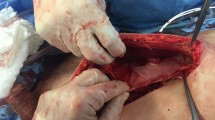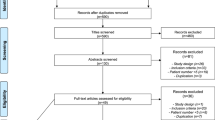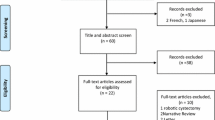Abstract
Parastomal hernias (PH) represent a clinically significant problem for many patients after radical cystectomy and ileal conduit diversion. The prevalence may be as high as 60 % and in some series, up to 30 % of patients require surgical intervention due to the complications of pain, poor fit of an ostomy appliance, leakage, urinary obstruction, and bowel obstruction or strangulation. Due to the potential morbidity associated with PH repair, there have been efforts to prevent PH development at the time of the index surgery. Four randomized trials of prophylactic mesh placement at the time of colostomy and ileostomy stoma formation have demonstrated significant reductions in PH rates with acceptably low complication rates. In this review, we describe the clinical and radiographic definitions of PH, the clinical impact and risk factors behind its development, and the rationale behind prophylactic mesh placement for patients undergoing ileal conduit urinary diversion. Additionally, we report our experience with prophylactic mesh placed at radical cystectomy at our institution.

Similar content being viewed by others
References
Papers of particular interest, published recently, have been highlighted as: • Of importance
Pearl RK. Parastomal hernias. World J Surg. 1989;13:569.
Israelsson LA. Parastomal hernias. Surg Clin N Am. 2008;88:113.
Gerharz EW, Mansson A, Hunt S, et al. Quality of life after cystectomy and urinary diversion: an evidence based analysis. J Urol. 2005;174:1729.
Kouba E, Sands M, Lentz A, et al. Incidence and risk factors of stomal complications in patients undergoing cystectomy with ileal conduit urinary diversion for bladder cancer. J Urol. 2007;178:950.
Goligher JC, Lloyd-Davies OV, Robertson CT. Small-gut obstructions following combined excision of the rectum with special reference to strangulation round the colostomy. Br J Surg. 1951;38:467.
Cuthbertson AM, Collins JP. Strangulated para-ileostomy hernia. Aust N Z J Surg. 1977;47:86.
Janes A, Cengiz Y, Israelsson LA. Randomized clinical trial of the use of a prosthetic mesh to prevent parastomal hernia. Br J Surg. 2004;91:280.
Serra-Aracil X, Bombardo-Junca J, Moreno-Matias J, et al. Randomized, controlled, prospective trial of the use of a mesh to prevent parastomal hernia. Ann Surg. 2009;249:583.
Hammond TM, Huang A, Prosser K, et al. Parastomal hernia prevention using a novel collagen implant: a randomised controlled phase 1 study. Hernia. 2008;12:475.
Lambrecht RJ, Larsen GS, Reiertsen O, et al. Prophylactic mesh at end-colostomy construction reduces parastomal hernia rate: a randomised trial. Color Dis. 2015.
Styrke J, Johansson M, Granasen G, et al. Parastomal hernia after ileal conduit with a prophylactic mesh: a 10 year consecutive case series. Scand J Urol. 2015;1. This is the only published series of prophylactic mesh placement in a cohort of urinary diversion patients.
Hautmann RE, Abol-Enein H, Lee CT, et al. Urinary diversion: how experts divert. Urology. 2015;85:233.
Farnham SB, Cookson MS. Surgical complications of urinary diversion. World J Urol. 2004;22:157.
Ripoche J, Basurko C, Fabbro-Perray P, et al. Parastomal hernia. A study of the French federation of ostomy patients. J Visc Surg. 2011;148, e435.
Martin L, Foster G. Parastomal hernia. Ann R Coll Surg Engl. 1996;78:81.
Marimuthu K, Vijayasekar C, Ghosh D, et al. Prevention of parastomal hernia using preperitoneal mesh: a prospective observational study. Color Dis. 2006;8:672.
Donahue TF, Bochner BH, Sfakianos JP, et al. Risk factors for the development of parastomal hernia after radical cystectomy. J Urol. 2014;191:1708. The largest series to date analyzing risk factors for radiographic PH development in patients undergoing ileal conduit diversion.
Liu NW, Hackney JT, Gellhaus PT, et al. Incidence and risk factors of parastomal hernia in patients undergoing radical cystectomy and ileal conduit diversion. J Urol. 2014;191:1313.
Wood DN, Allen SE, Hussain M, et al. Stomal complications of ileal conduits are significantly higher when formed in women with intractable urinary incontinence. J Urol. 2004;172:2300.
Bloom DA, Grossman HB, Konnak JW. Stomal construction and reconstruction. Urol Clin N Am. 1986;13:275.
Fontaine E, Barthelemy Y, Houlgatte A, et al. Twenty-year experience with jejunal conduits. Urology. 1997;50:207.
Janes A, Cengiz Y, Israelsson LA. Experiences with a prophylactic mesh in 93 consecutive ostomies. World J Surg. 2010;34:1637. This follow-on paper after their randomized trial demonstrates the applicability and safety of the technique in both the elective and emergent, contaminated cases.
Janes A, Weisby L, Israelsson LA. Parastomal hernia: clinical and radiological definitions. Hernia. 2011;15:189.
Moreno-Matias J, Serra-Aracil X, Darnell-Martin A, et al. The prevalence of parastomal hernia after formation of an end colostomy. A new clinico-radiological classification. Color Dis. 2009;11:173.
Seo SH, Kim HJ, Oh SY, et al. Computed tomography classification for parastomal hernia. J Korean Surg Soc. 2011;81:111.
Hong SY, Oh SY, Lee JH, et al. Risk factors for parastomal hernia: based on radiological definition. J Korean Surg Soc. 2013;84:43.
Parmar KL, Zammit M, Smith A, et al. A prospective audit of early stoma complications in colorectal cancer treatment throughout the greater Manchester and Cheshire colorectal cancer network. Color Dis. 2011;13:935.
Nastro P, Knowles CH, McGrath A, et al. Complications of intestinal stomas. Br J Surg. 2010;97:1885.
Pilgrim CH, McIntyre R, Bailey M. Prospective audit of parastomal hernia: prevalence and associated comorbidities. Dis Colon Rectum. 2010;53:71.
Caricato M, Borzomati D, Ausania F, et al. Prognostic factors after surgery for locally recurrent rectal cancer: an overview. Eur J Surg Oncol. 2006;32:126.
De Raet J, Delvaux G, Haentjens P, et al. Waist circumference is an independent risk factor for the development of parastomal hernia after permanent colostomy. Dis Colon Rectum. 2008;51:1806.
Arumugam PJ, Bevan L, Macdonald L, et al. A prospective audit of stomas—analysis of risk factors and complications and their management. Color Dis. 2003;5:49.
Emmott D, Noble MJ, Mebust WK. A comparison of end versus loop stomas for ileal conduit urinary diversion. J Urol. 1985;133:588.
McGrath A, Porrett T, Heyman B. Parastomal hernia: an exploration of the risk factors and the implications. Br J Nurs. 2006;15:317.
Rubin MS, Schoetz Jr DJ, Matthews JB. Parastomal hernia. Is stoma relocation superior to fascial repair? Arch Surg. 1994;129:413.
Horgan K, Hughes LE. Para-ileostomy hernia: failure of a local repair technique. Br J Surg. 1986;73:439.
Carne PW, Robertson GM, Frizelle FA. Parastomal hernia. Br J Surg. 2003;90:784.
Helgstrand F, Rosenberg J, Kehlet H, et al. Risk of morbidity, mortality, and recurrence after parastomal hernia repair: a nationwide study. Dis Colon Rectum. 2013;56:1265.
Janes A, Cengiz Y, Israelsson LA. Preventing parastomal hernia with a prosthetic mesh: a 5-year follow-up of a randomized study. World J Surg. 2009;33:118. The authors’ randomized trial was terminated early due to the overwhelming superiority of prophylactic mesh placement in reducing the rates of clinical parastomal hernia formation. This 5-year follow up of the cohort from the RCT provides intermediate term data on the efficacy of prophylactic mesh placement.
Shabsigh A, Korets R, Vora KC, et al. Defining early morbidity of radical cystectomy for patients with bladder cancer using a standardized reporting methodology. Eur Urol. 2009;55:164.
Author information
Authors and Affiliations
Corresponding author
Ethics declarations
Conflict of Interest
The authors declare that they have no competing interests.
Human and Animal Rights and Informed Consent
This article does not contain any studies with human or animal subjects performed by any of the authors.
Additional information
This article is part of the Topical Collection on Urothelial Cancer
Rights and permissions
About this article
Cite this article
Donahue, T.F., Cha, E.K. & Bochner, B.H. Rationale and Early Experience with Prophylactic Placement of Mesh to Prevent Parastomal Hernia Formation after Ileal Conduit Urinary Diversion and Cystectomy for Bladder Cancer. Curr Urol Rep 17, 9 (2016). https://doi.org/10.1007/s11934-015-0565-z
Published:
DOI: https://doi.org/10.1007/s11934-015-0565-z




